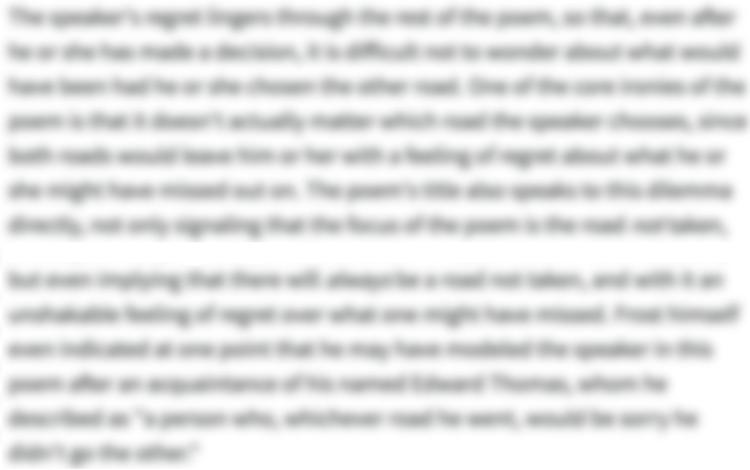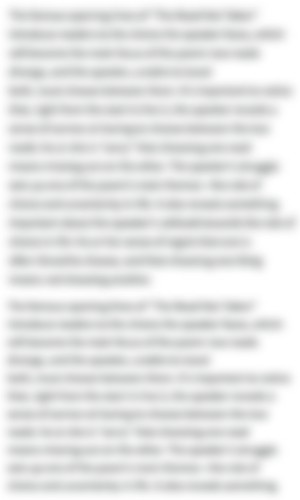The Full Text of “The Lake Isle of Innisfree”
1I will arise and go now, and go to Innisfree,
2And a small cabin build there, of clay and wattles made;
3Nine bean-rows will I have there, a hive for the honey-bee,
4And live alone in the bee-loud glade.
5And I shall have some peace there, for peace comes dropping slow,
6Dropping from the veils of the morning to where the cricket sings;
7There midnight’s all a glimmer, and noon a purple glow,
8And evening full of the linnet’s wings.
9I will arise and go now, for always night and day
10I hear lake water lapping with low sounds by the shore;
11While I stand on the roadway, or on the pavements grey,
12I hear it in the deep heart’s core.
-
“The Lake Isle of Innisfree” Introduction
-
William Butler Yeats wrote “The Lake Isle of Innisfree,” one of his most famous and widely-anthologized works, in 1888. The poem gets its title from a very small, uninhabited island that sits in Lough Gill, a lake in Yeats’s home county of Sligo, Ireland. The speaker of this pastoral poem longs to build a simple life on Innisfree, finding peace through communion with nature. However, it becomes clear that ties to city life prevent the speaker from realizing this dream. The young poet’s fixation on questions of spirituality and Irish identity is felt in this poem, which also contains the sort of archaic language that he would later abandon and decry. Following an ABAB rhyme scheme and loosely iambic meter, the poem’s seemingly neat, concise structure belies its complex networks of rhythm and sound, which are responsible for much of its visceral impact and enduring popularity.
-
-
“The Lake Isle of Innisfree” Summary
-
The speaker expresses an intention to get up and go to a small island in Ireland called Innisfree. On the island, the speaker wishes to build a modest cabin out of clay and bundled twigs. The speaker hopes to plant nine rows of beans in a clearing, which will buzz with the sound of honeybees tending to a nearby hive.
The speaker believes that this setting promises peace, which will emerge slowly as the hazy mist of the morning falls to the earth, where crickets chirp. On the island, light flickers beautifully in the middle of the night and glows with a purple hue at midday, while little birds flutter about in the evenings.
The speaker reiterates an intent to get up and go to Innisfree, explaining that all day and all night, the speaker imagines hearing the lake's waves breaking on the island's shore. As the speaker stands on roads or other paved places, that imagined lake sound resonates deep within the speaker's heart.
-
-
“The Lake Isle of Innisfree” Themes
-
Nature and Spirituality
The poem's speaker fantasizes about building a solitary, peaceful life on Innisfree, an uninhabited island in Ireland. While providing a dreamy, picturesque view of the island, the speaker also emphasizes the incompatibility of its virtues with modern life. In doing so, the speaker suggests that a return to nature offers unique spiritual rewards.
When describing Innisfree, the speaker uses mystical language, praising the natural world as a strong spiritual force. The poem opens with the phrase “I will arise and go,” which appears word-for-word twice in the King James Version of the Bible (Yeats, born into a Protestant family, likely used this text for worship). This allusion to the Bible at the poem’s very outset establishes that the speaker’s concerns—and especially the fixation on Innisfree—are spiritual in nature.
Subtle references to religious tradition continue, such as “the veils of morning”—a metaphor that likens early morning weather, such as fog and dew, to head coverings often worn for religious purposes. Plus, phrases like “purple glow” and “midnight’s all a glimmer” build a dreamy, supernatural atmosphere. Moreover, the speaker clearly feels a deep, personal connection to Innisfree, claiming that it calls out “always night and day,” relentlessly summoning the speaker. The two share a spiritual kinship, as nature lives within the speaker, who hears it “in the deep heart’s core.” The speaker believes that heeding its calls will bring “some peace.” Thus, the speaker champions nature as a profound divine force that can bring about inner serenity.
At the same time, the speaker emphasizes that communion with nature is the only path to attaining such spiritual rewards. In other words, modern society interferes with the pursuit of peace and truth. The speaker repeats the phrase “I will arise and go” as well as “and go.” As such, the speaker expresses a deep, persistent desire to get up and leave the city.
When describing an ideal life on the island, the speaker also notably refers to Innisfree four times as “there.” In doing so, the speaker stresses that fulfillment cannot be achieved “here”—that is, in the present, urban setting. In lines 4-5, the speaker implies that spiritual awakenings occur only outside of advanced societies and large communities, and instead when individuals are in tune with nature. In particular, the speaker expresses an intent to “live alone” on Innisfree, right before declaring “I shall have some peace there.”
Finally, in the poem’s penultimate line, the sound of splashing water entrances the speaker, who “stand[s] on the roadway, or on the pavements grey.” The inversion at the end of this line calls attention to the descriptor “grey,” playing up the bleak austerity of city life as a critical barrier to spiritual pursuits.
The speaker thus presents nature as a profound spiritual force that contains essential truths—a wellspring of wisdom that can only be accessed via a total renunciation of modern society. However, the speaker remains embedded within an urban landscape, despite nature calling “always night and day.” By revealing the chasm between the speaker’s daydream and reality, the poem implicitly questions the attainability of a meaningful connection with nature in modern civilization.
- See where this theme is active in the poem.
-
Labor and Fulfillment
While highlighting the spiritual fulfillment that nature promises, the speaker also points out specific tasks that must be undertaken and exacting circumstances that must be endured to attain this fulfillment. In this way, the speaker champions quiet, meditative labor as the means to realizing the spiritual bounty of the natural world.
The poem’s first stanza details the various ways in which the speaker must cultivate the land in order to live in harmony with nature on Innisfree. First, the speaker has to get to Innisfree, which is a task in and of itself. Indeed, the speaker has been stuck in the city for some time, yearning “always night and day” to connect with nature but struggling to break away.
Upon arriving at Innisfree, the speaker would then have to make a clearing or “glade.” From there, the speaker would have to build a shelter using crude raw materials—weaving twigs and branches to create a cabin’s frame and then packing it with clay. Next, the speaker would move on to cultivate a sustainable source of food, such as “Nine bean-rows.” This would entail creating a garden bed, working the soil, sowing seeds, and tending to plants. The speaker thus lays out several prolonged, laborious projects that one must embark on in order to live cooperatively with nature.
To the same end, the speaker contends that one must adapt to a broader set of challenging conditions that goes beyond methodically nurturing the land. The speaker expresses an intent to “live alone” on the island, emphasizing that living in harmony with nature requires solitude. But as the speaker demonstrates, ties to modern society hold back even those most desirous of a profound connection with nature. As such, one must exercise great strength and resolve to break with the conveniences that communities and modern technologies provide.
What’s more, complying with all of the above does not result in immediate gratification, as “peace comes dropping slow.” The speaker thus advocates for an appreciation of labor for its own sake—not expecting any grand reward for individual accomplishments. In this way, the speaker indicates that one must complete certain tasks and adapt one’s outlook in patient pursuit of a larger purpose. It is such meditative contentment with one’s labor that will ultimately bring about spiritual fulfillment.
- See where this theme is active in the poem.
-
-
Line-by-Line Explanation & Analysis of “The Lake Isle of Innisfree”
-
Line 1
I will arise and go now, and go to Innisfree,
The speaker opens the poem by expressing a desire to travel to Innisfree—a small, uninhabited island in a lake known as Lough Gill, in County Sligo, Ireland, where Yeats lived as a child.
Yeats once said that he could not remember if he chose the island for its lyrical name or its association with Irish folklore. Both motives have relevant implications. The island’s name ends with “free,” a fact that is accentuated by its position at the end of the poem’s first line. As the reader will soon learn, the speaker seeks freedom from city life—its sights, sounds, crowd, and obligations. The island’s association with folklore—and in particular with the Danaan quicken tree, which is said to bear the fruit of faeries—plays into its mystical portrayal within the poem.
To the latter point, the phrase that commences the poem is an allusion to the Bible. “I will arise and go” appears numerous times in several forms throughout the King James Bible—in all likelihood the text that Yeats used for worship, as he was a Protestant. As the phrase crops up in many different contexts, it is difficult to say if it is meant to invoke the Bible in general or a particular verse.
One possible origin is the Parable of the Prodigal Son, which is the best-known story that contains this phrase word-for-word. The Book of Luke tells of a young man, who asks his father for his inheritance, before squandering it and being forced into indentured servitude. Eventually, he returns home to repent, saying “I will arise and go to my father,” who meets him with forgiveness. If this is the story the speaker intends the audience to recall, the direct replacement of “father” with “Innisfree” within the poem suggests that nature is a godly and forgiving force, capable of redeeming a lost soul. In any case, the biblical language establishes that the speaker’s imagined life on Innisfree is part of a spiritual journey.
The repetition of “and go,” an example of anadiplosis, reiterates the speaker’s intention to travel to the island. As such, the speaker comes across as insistent and determined. At the same time, the repetition underscores that the speaker must leave the present locale—get up and go—in order to lead a meaningful life. It also calls attention to “now” and “to Innisfree,” linking them, as each phrase appears directly after “and go,” and directly before a comma. Thus, the repetition emphasizes the speaker’s desire to depart for Innisfree as soon as possible.
This first line establishes many of the formal rules that will govern the rest of the poem. Here is a look at its meter:
I will | arise | and go now, || and go | to In- | nisfree,
This line is in hexameter, meaning it contains six stresses. It is divided in half by a caesura, with three stresses falling before the comma and three stresses falling after it. Furthermore, there is an unstressed syllable on either side of the caesura, and the line ends in a stress, which is followed by an end-stop. Finally, it is comprised of 13 syllables and adheres to a loosely iambic rhythm (da-DUM). Of course, this iambic rhythm is complicated by the unstressed syllable in the third foot, creating a wafting, airy feeling in the middle of the stanza.
The first three lines of each stanza will follow these guidelines, with a just few minor divergences. The rise and fall of the iamb create a chant-like cadence that is punctuated by caesurae and end-stops, which keep it from becoming too singsong. The complexity of the rhythm makes it difficult for readers to put their fingers on what exactly makes the poem so entrancing—its mysteriousness heightening the mystical atmosphere.
-
Lines 2-4
And a small cabin build there, of clay and wattles made;
Nine bean-rows will I have there, a hive for the honey-bee,
And live alone in the bee-loud glade.

Unlock all 492 words of this analysis of Lines 2-4 of “The Lake Isle of Innisfree,” and get the Line-by-Line Analysis for every poem we cover.
Plus so much more...
Get LitCharts A+ -
Lines 5-6
And I shall have some peace there, for peace comes dropping slow,
Dropping from the veils of the morning to where the cricket sings; -
Lines 7-8
There midnight’s all a glimmer, and noon a purple glow,
And evening full of the linnet’s wings. -
Lines 9-10
I will arise and go now, for always night and day
I hear lake water lapping with low sounds by the shore; -
Lines 11-12
While I stand on the roadway, or on the pavements grey,
I hear it in the deep heart’s core.
-
-
“The Lake Isle of Innisfree” Symbols
-
Innisfree
Innisfree symbolizes an ideal image of nature. While Innisfree is a real island in Ireland, it represents more than a physical location within the poem. In reality, its terrain is quite uneven, so clearing and planting a glade on the island would be unfeasible, never mind constructing a cabin. Plus, it is mostly covered with trees, undergrowth, and shrubs—not necessarily the sort of fauna that would make the island buzz with the sound of honeybees.
Instead, Innisfree represents idealized nature, which is inherently unattainable. It embodies a deep spiritual fulfillment that city life cannot offer, causing urban-dwellers to long for a countryside they have never really known. As such, the island promises an alternative way of life for the speaker and others to aspire to. As a romanticized symbol of nature’s bounty, Innisfree is a state of mind—a daydream that offers a momentary escape from city life.
- See where this symbol appears in the poem.
-
The Cabin
The cabin that the speaker imagines building symbolizes the simple lifestyle that is required to access nature's wisdom. It is described as "small" and constructed out "of clay and wattles." The cabin's size and materials suggest that a humble way of life is key to achieving spiritual fulfillment. Further, "wattles" result from the meticulous, time-consuming action of weaving twigs, branches, and other brushwood together. By emphasizing the method of the cabin's construction, the speaker indicates that meditative labor is another essential element of this lifestyle.
The other components that comprise the speaker's home support this interpretation. More specifically, the "nine bean-rows" are a very modest, bare-bones garden, but cultivating that garden would take exceptional patience and dedication. Meanwhile, the "hive" would buzz with honeybees methodically collecting and depositing pollen and nectar. Plus, constructing the cabin, garden, and hive requires the speaker to work cooperatively with nature. In this way, the accommodations that the speaker intends to build represent a simple lifestyle—one that prioritizes humility, disciplined labor, and thoughtful engagement with the natural world.
- See where this symbol appears in the poem.
-
Light
Light appears briefly in line 7, where the speaker describes it flickering at midnight and glowing with a purple hue at midday. Light is a longstanding symbol of truth and clarity. Here, it can be interpreted as spiritual enlightenment. Midnight marks the end of one day and the beginning of another—the speaker’s transition to a new life on Innisfree. Although the island is initially dark, its wisdom difficult to make out, the speaker sees flashes or “glimmers” of divinity. As the day goes on and the speaker’s spiritual journey progresses, nature’s essential truths reveal themselves, its metaphysical power shining through. The “purple glow” that the light takes on signals that the island’s spiritual force is majestic and, over time, its wisdom becomes more intense and intelligible.
- See where this symbol appears in the poem.
-
Roads and Pavements
The "roadway" and "pavements grey" symbolize the ugliness and boredom of urban life.
Line 11 reveals that the speaker's longing for Innisfree is rooted in disillusionment with city life. The last two words of this line are reversed (rather than "grey pavements") to emphasize the descriptor "grey," calling attention to the speaker's blasé, resentful attitude towards the urban environment. The "roadway" and "pavements" are land that has been disfigured for and by humans. Thus, they can be interpreted as the negative qualities of cramped city living and industrialization, which are designed to create a more efficient society but keep its inhabitants from reaching spiritual fulfillment. The speaker contrasts the beauty of Innisfree with this ugly image of modern infrastructure to emphasize the disparity between the speaker's aspirations and reality.
- See where this symbol appears in the poem.
-
-
“The Lake Isle of Innisfree” Poetic Devices & Figurative Language
-
Allusion
The poem opens with the statement, "I will arise and go," which is an allusion to the Bible. This phrase appears word-for-word twice in the King James Bible, which Yeats likely used for worship, as he was a Protestant. It also crops up in several places in slightly modified forms—for instance, "let us arise and go," and later, "we will arise and go," both in Genesis, the first book of the Old Testament. As a result, it is unclear if the speaker is invoking a particular story or biblical language more broadly. Regardless, the allusion signals that the speaker is embarking on a spiritual journey
The famous Parable of the Prodigal Son contains the exact phrase in question. Because it is the most familiar biblical story that does so, the following discussion will serve as an example of the meaning that the allusion might bring to certain readings. Jesus shares the parable with his disciples in Chapter 15 of the Book of Luke. As the story goes, there is a man with two sons, the younger of whom has traveled far from home and squandered his inheritance by living an extravagant lifestyle. Eventually, this son runs out of money, at which time a severe famine sweeps the land, leaving him destitute.
After failing to make a living as a lowly swineherd, he vows to return home:
I will arise and go to my father, and will say unto him, Father, I have sinned against heaven, and before thee,
And am no more worthy to be called thy son: make me as one of thy hired servants.
His father meets him with forgiveness and generosity, celebrating his return. When the older son protests, his father explains, "It was meet that we should make merry, and be glad: for this thy brother was dead, and is alive again; and was lost, and is found."
By recalling this story, the allusion indicates that disavowing one’s worldly possessions and returning to nature is analogous to the prodigal son renewing his devotion to God and returning home. The direct replacement of “father” with “Innisfree” lifts nature up as a godly, healing, and forgiving force.
The allusion reappears at the poem's conclusion, displaying the speaker's determination to find spiritual fulfillment through living a modest life on Innisfree.
- See where this poetic device appears in the poem.
-
Assonance


Unlock all 319 words of this analysis of Assonance in “The Lake Isle of Innisfree,” and get the poetic device analyses for every poem we cover.
Plus so much more...
Get LitCharts A+ -
Caesura
-
Consonance
-
End-Stopped Line
-
Metaphor
-
Repetition
-
-
“The Lake Isle of Innisfree” Vocabulary
Select any word below to get its definition in the context of the poem. The words are listed in the order in which they appear in the poem.
- I will arise and go
- Arise
- Innisfree
- Wattles
- Bean-Rows
- Bee-Loud
- Glade
- Shall
- Dropping
- Veils
- Linnet
- Lapping
I will arise and go-
This statement, which essentially expresses an intention to get up and go somewhere, appears several times in the King James Version of the Bible—the text Yeats likely used for worship, as he was a Protestant. The phrase appears word-for-word in 2 Samuel 3:21 as well as Luke 15:18 and shows up in modified forms elsewhere. The precise implications of this allusion are explored in the Poetic Devices section, but in general, it signals that the island offers spiritual rewards.
- See where this vocabulary word appears in the poem.
-
Form, Meter, & Rhyme Scheme of “The Lake Isle of Innisfree”
-
Form
This poem does not follow a traditional, established verse form, but its structure is nevertheless straightforward. It consists of three four-line stanzas, or quatrains. Each stanza is comprised of one long sentence, divided in half by a semicolon at the end of its second line.
Almost every line is also end-stopped, and the period that concludes each stanza neatly divides the poem into three parts. In the first stanza, the speaker imagines building a meaningful life on the island; in the second, the speaker envisions what it might be like to experience its divine energy; and in the third, in the present moment, the speaker remains trapped in a state of longing and urban drudgery.
Furthermore, each stanza contains three longer lines, followed by one shorter line. The longer lines are all divided in half, usually by a caesura, but in some cases by a natural pause, as in lines 6 and 10. In general, the resulting hemistichs, or half-lines, reinforce the poem's meter and call attention to words that fall immediately before the pauses. For example, "there" appears before the caesurae in lines 2, 3, and 5, emphasizing the speaker's need to travel out of the city and into the natural world to find fulfillment.
Similarly, end-stops accentuate the poem's rhythm and highlight end words, in turn exaggerating the speaker's use of rhyme. In fact, all lines but one—line 9—are end-stopped. Line 9 describes the incessant pull that the speaker feels towards Innisfree. As a result of the enjambment that follows, "for always night and day" lingers in space indefinitely, much like the speaker's longstanding, unresolved yearning.
-
Meter
The poem’s meter varies slightly from line to line and does not adhere to an established verse form. Instead, it follows its own intricate set of rules. Due to the poem’s popularity and metrical complexity, scholars have debated its precise pattern of stressed and unstressed syllables. This analysis reconstructs the poem's meter using recordings of Yeats’s readings.
For starters, the first three lines of each stanza are written in hexameter, containing six stressed syllables, while the final lines are written in tetrameter, containing four stressed syllables. For example, here is a look at lines 3-4:
Nine bean- rows will I have there, || a hive for the honey-bee,
And live alone in the bee-loud glade.Furthermore, each hexameter line is divided in half, usually by a caesura in the form of a comma, though natural pauses divide lines 6 and 10. Each half-line, or hemistich, contains three stresses. The first hemistich of each hexameter line ends in an unstressed syllable, while each second hemistich begins with an unstressed syllable. In other words, an unstressed syllable surrounds the pause on either side. Plus, every line ends in a stress, while most lines begin with an unstressed syllable.
Line 2 also contains all of these characteristics:
And a small cabin build there, || of clay and wattles made;
The hexameter lines usually contain 13 syllables, though line 3 contains 14 and line 6 contains 15. Similarly, the first two tetrameter lines contain 9 syllables, while the final tetrameter line contains 8.
Finally, the meter follows a loosely iambic rhythm (da-DUM). However, as the examples above show, this is extremely variable, and the poem often falls into trochaic (DUM-da), anapestic (da-da-DUM), and dactylic (DUM-da-da) rhythms as well. As such, the rhythm rises, falls, and pauses over and over again. Within this structure, the poem's complexity and lack of uniformity make its patterns difficult to detect. As a result, the speaker’s cadence is mysteriously incantatory—as if casting a spell over readers, it lulls them into the speaker’s daydream. Its enchanting rhythm has made the poem a popular choice for musical adaptations.
Yeats himself has noted the importance of meter to this poem, famously exaggerating its rhythm during readings. He explained why during a recording session with the BBC:
I am going to read my poems with great emphasis upon their rhythm, and that may seem strange if you are not used to it. I remember the great English poet, William Morris, coming in a rage out of some lecture hall where somebody had recited a passage out of his Sigurd the Volsung, ‘It gave me a devil of a lot of trouble’, said Morris, ‘to get that thing into verse’. It gave me a devil of a lot of trouble to get into verse the poems that I am going to read, and that is why I will not read them as if they were prose.
In fact, the meter of "Innisfree" closely mirrors that of Morris's epic, which also features hexameters comprised of two hemistichs containing three stresses each. Further, both works strictly follow a regular pattern of stresses per hemistich and line, but are not overly concerned with where those stresses fall.
-
Rhyme Scheme
In contrast to its meter, this poem's rhyme scheme is very straightforward:
ABAB CDCD EFEF
Each line ends on a stressed syllable and all but one is end-stopped, accentuating the rhymes.
Additionally, the poem contains several internal rhymes, such as “for” and “or,” which highlight the end rhyme between “shore” and “core” in the final stanza. Additionally, "go" rhymes with "low" in the same stanza; "there" in line 5 rhymes with "where" in line 6, and "some" and "comes" rhyme in line 5. Relatedly, the poem also employs a slant rhyme with the phrases "cricket sings" and "linnet's wings" in the same stanza.
In general, rhyme works with meter and other sonic effects such as assonance and consonance to increase the poem’s musicality. It also deepens the poem’s meaning by calling attention to keywords and linking distinct images and ideas. For instance, here’s a look at lines 9 and 11:
I will arise and go now, for always night and day
While I stand on the roadway, or on the pavements grey,
The end rhyme between "day" and "grey" is picked up in "roadway" as well as the slant rhyme "always" and the assonant long /ay/ in “pavements.”
The repeating sounds throughout this stanza call attention to the end rhyme. Furthermore, the inversion at the end of line 11 places additional emphasis on the descriptor “grey,” which highlights the speaker’s dreary attitude towards city life. As such, by directly linking “day” and “grey,” rhyme suggests that the speaker’s yearning for nature stems from a dissatisfaction with the present urban setting. The resulting chorus of repeating sounds is akin to the speaker's observations of nature, such as “the bee-loud glade,” “the cricket sings,” and “lake water lapping with low sounds.”
-
-
“The Lake Isle of Innisfree” Speaker
-
The poem does not reveal any specific biographical information about the speaker. The reader gathers that the speaker lives in an urban environment and pines to leave it behind, in favor of a simpler life on Innisfree.
Indeed, the poem is essentially a reverie, the speaker imagining what it would be like to find fulfillment through building a life on the island. As such, the speaker comes across as starry-eyed and idealistic. But in addition to being highly romantic, the speaker’s tone is insistent, twice stating “I will arise and go” in addition to “I have” and “I shall.” In this way, the speaker seems determined to make this dream a reality, though there are signs to the contrary, as the speaker has had these aspirations for some time but hasn’t gotten any closer to realizing them.
Yeats wrote this poem when he was 23, living in London and missing Ireland. The speaker is often interpreted as a young Yeats, and the poet himself has suggested that this is the case on several occasions. Here is a passage from his memoir Four Years:
I had still the ambition, formed in Sligo in my teens, of living in imitation of Thoreau on Innisfree, a little island in Lough Gill, and when walking through Fleet Street very homesick I heard a little tinkle of water and saw a fountain in a shop-window which balanced a little ball upon its jet, and began to remember lake water. From the sudden remembrance came my poem “Innisfree,” my first lyric with anything in its rhythm of my own music.
However, this description is something of a distortion, as the poem began as prose—part of John Sherman, Yeats’s only published novella and a volume he later disavowed. The story’s eponymous character is the poem’s original speaker—a young man about 30 or so, who moves to London but longs for his hometown in the west of Ireland.
Still, in its final form, which is quite different from the original, the poem reveals very little about its speaker, so it’s prudent to refrain from ascribing any definite age, gender, or other identifiers to the speaker.
-
-
“The Lake Isle of Innisfree” Setting
-
Given Yeats’s biography and the passage in his novella John Sherman from which this poem originates, it would be fair to interpret the setting as late-19th-century London. However, in the poem itself, the speaker simply states, “I stand on the roadway, or on the pavements grey.” Thus, the setting could reasonably be any city, likely one relatively close to Innisfree, which is in western Ireland. Further, although the rapid urbanization of the late 19th century undoubtedly informs the poem, there is no indication of when exactly in history it takes place.
The speaker’s physical environment is not revealed until the final lines. Instead, the majority of the poem takes place within a dreamlike reverie—an idealization based on memory, imagination, and lore that the speaker hopes to experience, but that isn’t truly attainable.
Yeats himself described local lore surrounding Innisfree—particularly its association with the Danaan quicken tree. As the story goes, the Danaan quicken tree bears the fruit of the faeries and is guarded by a beast. A young woman implored her lover to kill the beast and bring her the fruit, which he did. However, he tasted it and perished as he reached the shore due to its magnificent power. The young lady, overcome with grief, ate the fruit and died beside him.
Though the poem does not directly reference the tale, the island’s supposed mystical powers are consistent with the spiritual language that the speaker uses to describe Innisfree. Moreover, the speaker’s longing for the island could be interpreted as a desire for a return to Irish cultural tradition.
-
-
Literary and Historical Context of “The Lake Isle of Innisfree”
Literary Context
Although Yeats has obscured its origin, “The Lake Isle of Innisfree” began as a passage from an early draft of his only published novella, John Sherman. The story’s titular character struggles to transition from a relaxed life in the lush, beautiful Irish countryside to the meanness of London. Like Sherman, the poem’s speaker longs for western Ireland and a simpler lifestyle in harmony with the natural world.
Yeats is known for being highly critical of his early work and downplayed the novella. He often revised poems and other works after their initial publication (he even rewrote letters after sending them!). However, “The Lake Isle of Innisfree” is unique in that he hardly fussed with it, adding only a comma after its appearance in The National Observer in 1890, two years after it was written. This deviation from his usual treatment of early poems speaks to the obsessive care Yeats took when composing “Innisfree,” which went through several drafts and follows very intricate metrical patterns. Yeats cited this poem as “my first lyric with anything in its rhythm of my own music” and performed it at readings often.
Throughout his life and writings, Yeats displayed a voracious fixation on all things spiritual, including religion, the occult, and paranormal phenomena. While his later work was far more modernist in nature, Yeats’s early poems were shaped by Romantics like William Blake ("London") and Percy Bysshe Shelley ("Love’s Philosophy"). As a teenager, Yeats read Henry David Thoreau’s Walden, which gives an account of Thoreau's two-year spiritual and intellectual journey while living alone in a cabin on Walden Pond in Massachusetts.
Thoreau was a leading practitioner of transcendentalism, an offshoot of Romanticism. This philosophical and social movement was centered around the belief that divinity runs throughout humankind and the natural world, which are therefore inherently good. As a young man, Yeats wanted to follow in Thoreau’s path, living in solitude and harmony with nature. He named Walden as this poem’s chief influence. One chapter in Walden is titled “The Bean-Field,” which resonates with the “Nine bean-rows” in the third line of "The Lake Isle of Innisfree."
While Yeats identified as an Irish Nationalist (see Historical Context below), he was less concerned with political revolution than questions of cultural identity. He turned to local folklore and mythology, which greatly informed his early writings, publishing the compilation Fairy and Folk Tales of the Irish Peasantry in the same year that he wrote “Innisfree.” He has been credited as a leading figure of the Celtic Revival.
The popularity and reach of “The Lake Isle of Innisfree” cannot be overstated. It is probably Yeats’s best-known poem, which is significant as he is by and large considered one of the most important literary figures of the twentieth century. The poem’s incantatory rhythms have spawned many musical adaptations, such as Judy Collins’s "Innisfree." In addition to countless songs, the poem has inspired films, novels, and even an eco-friendly South Korean makeup brand, whose concept centers around Jeju Island. Of course, numerous poets have riffed on “Innisfree”—see Ezra Pound’s "The Lake Isle" for one example.
Historical Context
In the UK and beyond, the Second Industrial Revolution brought on a slew of new technologies in the late 19th and early 20th century. In particular, major advancements in manufacturing expanded industry, and as railways and telegraph lines became more plentiful and accessible, people flocked to urban areas in hopes of finding work. The urbanization that followed resulted in overcrowding and poor living conditions for the working class.
The Yeats family was struggling financially in the late 1880s, when the poet was in his early 20s. He moved with his family back to London, where they had lived intermittently when he was a boy. Like his mother, Yeats detested living in London. Such sentiment was growing amongst city dwellers, leading to an increased idealism about the countryside and natural world more broadly. The transcendentalist movement, which Yeats identified with as a young man, contended that industrialism was a barrier to inner peace and knowledge. Instead, there was an enduring wisdom that only communion with nature could provide. Yeats cited his yearning for Sligo, his home county in western Ireland, as the source of inspiration for “The Lake Isle of Innisfree.”
Earlier in life, Yeats was educated in London schools, where he experienced anti-Irish sentiment. Around this time, the Home Rule Party was formed with the goal to create an Irish Parliament that could legislate separately from Britain’s main Parliament. Other Irish political leaders advocated full independence from Britain—its proponents were called Irish Nationalists. Furthermore, the Land League was formed to give Irish peasants the leverage to negotiate fair prices with their landlords. Violence erupted as a result of the peasant's boycotts, leading to the Land War. Yeats's role in the Celtic Revival emerges from this political context.
-
More “The Lake Isle of Innisfree” Resources
-
External Resources
-
Yeats reads "The Lake Isle of Innisfree" — Listen to a recording of Yeats reading the poem, exaggerating its rhythm.
-
David Holdeman on Yeats — A short clip of a Yeats scholar explaining his take on the poem.
-
Profile of William Butler Yeats — A detailed overview of Yeats's life and work from the Poetry Foundation.
-
Can Humans Control the Natural World? — A module on urbanization, industrialization, and humans’ relationship to nature in the 19th century, including a discussion of contemporary literature.
-
Online Exhibition: The Life and Works of William Butler Yeats — A digital version of a wide-ranging exhibition on Yeats at The National Library of Ireland, which houses the world's largest collection of his manuscripts.
-
A Brief History of the Irish Nationalist Movement — A summary of Irish Nationalism and related movements and conflicts in the late 19th century.
-
-
LitCharts on Other Poems by William Butler Yeats
-














